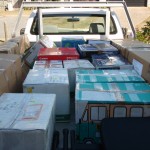
Moving day!!
You will have quite a few choices when it comes to storing your things. If you’ve never used storage before, here is the list that will simplify the process and help you on your way:
1. Do you REALLY need to store your stuff? Is this stuff you will ever use again? You should establish that ‘Yes’ you do want to keep the stuff you are thinking of storing, and whether keeping it will be worth paying the storage rate.
2. Work out how much stuff you have to store. This is usually calculated in cubic metres. You can either stack all your stuff in a square pile and measure the height, width and depth and multiply these numbers. For example a pile 2 metres wide by 3 metres deep by 2 metres high (2x3x2) equals 12 cubic metres. The alternative is to work out the cubic metre size of each item and add it all together at the end. A free online space calculators are available here
3. Next, decide what kind of storage you are looking for. You have a choice of ‘Traditional Self Storage’ – this is typically the highest priced choice but offers the most features like high security and your own storage unit. You can search here
Then there’s ‘Warehouse Storage Space’ which means you rent a portion of big warehouse next to other people’s stuff. This is usually cheaper than a Self Storage Unit, but you usually have to pay to have your stuff stacked both in and out.
Lastly, you can now use new online Private Storage Services like the first and biggest SpaceOut.com.au. Sites like SpaceOut allow people with a spare room, shed or garage in their house or business to advertise it to people seeking space. This is typically the cheapest option and can be a great way to offset the costs associated with storage. Look carefully at the spaces on offer to make sure you get just what you want.
4. Once you’ve found an appropriate storage site, you’ll need to actually move your things. Depending on how much you have, you made be able to use your car which is probably the cheapest option. However, if you have a lot of stuff, you may need to rent a Ute, a small truck (you can drive up to a 3 ton truck on your regular car license), or you may even consider a removalist.
Look carefully at your budget for moving and consider if multiple small trips in a smaller vehicle may work out cheaper than one big trip in a larger option. You can find rental vehicles and removalists online for your area – go with a reputable company, and consider whether the value of your stuff is worth insurance for the move.
Insurance can usually be arranged through the removalists or rental vehicle company.
5. The moving day can take some coordinating, so particularly if you have opted for the cheapest option above – Private Storage, you will need to make sure the space owner has prepared for your move in. Stay in close contact with him/her until your move is complete, and we recommend some kind of binding agreement. The SpaceOut site provides a template for free.
It is better to allow more time than less to move, so start early in the day if possible.
6. Payment: the easiest way to pay ongoing for your storage is by automatic bank transfer – you can set this up through your bank, and most Self Storage facilities will set up a regular credit card payment for you.
And that’s about it! If I’ve missed any big points, let me know. And I’d love to hear of your storage story – good OR bad.

